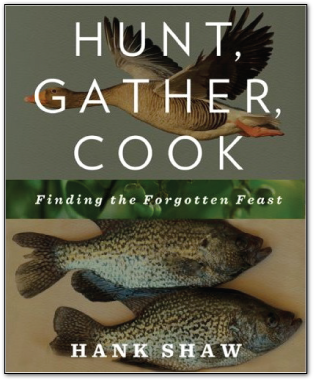
It can be so rewarding to meet another wild food aficionado and talk shop, even more interesting to meet a published forager on a cross-country book tour. Let's add a gourmet dinner out at a nice restaurant made with local, fresh wild food that you have foraged for the restaurant, and the evening is complete. On October 2, 2011 we lived this reality when we chatted and dined with Hank Shaw, author of
Hunt, Gather, Cook: Finding the Forgotten Feast and his website
Hunter Angler Gardener Cook. The dinner was held at La Laiterie in Providence, Rhode Island, and it consisted of passed appetisers and four courses, each containing at least one item we had foraged and contributed to the evening.

Hank is originally from New Jersey, and spent his summers on Block Island. He currently lives in Northern California, where the produce is different, the ocean is different, but foraging for wild food is still a passion. His book is broken into three main sections: plants, fishing, and hunting. There are recipes throughout, along with lovely personal stories and memories. We generally don't have time to fish, and Robert and Gillian are vegetarian anyway so we also don't hunt. I have accepted gifts of venison, and may consider taking up bow hunting in the future. The section of the book we found most interesting was on the wild plants, especially the seaside edibles like beach peas, glasswort, and rocket. He also goes over other plants like dandelion, nettles, sassafras, and elderberries. This is not a guidebook for foraging wild edibles, but a complete story of the experiences and passions of an avid outdoorsman and forager.
I had contacted the chef of Farmstead & La Laiterie about possibly foraging for this dinner, and Matt Jennings was very enthusiastic. He and Beau Vestal cooked up a fantastic menu, including Hank's requested quahogs in honor of his Block Island memories. We provided autumn olives, chestnuts, black trumpets, spicebush berries, rosehips, ramps bulbs, and glasswort. Some of the items were unexpectedly difficult to gather, due to Tropical Storm Irene that just passed through and devastated the coastal areas we use to gather several items. The dry summer also limited our ability to forage for wild grapes and autumn olives. We did manage to find enough for the dinner, but will have to wait until next year to forage them for ourselves. Robert was unable to photograph the dishes, as the restaurant was rather dimly lit for ambiance, but I will say that everything was divine. My favorites include the candied spicebush berry, and the swordfish belly with the rosehip purée. Robert had an altered menu, with seaweed salad in place of the terrine, and white cheddar grits and hen of the woods mushroom sautée in place of the guinea hen. Both Hank and Matt Jennings reminded the diners that this was a unique feast, never to be replicated since the foods we ate that night were foraged that week from this geographic area, and cooked by wild food lovers and enthusiasts. It was wonderful! Here is a copy of the menu for the evening:

farmstead & la laiterie
presents
The Forgotten Feast
A Wild, Sourced Dinner
Reception
Wild Mushroom Toasts, Moses Sleeper Cheese, Preserved Lemon Mostarda
"Boar ta della" Sandwiches with Olive, Wild Juniper, and Celery Relish
Chicken-Fried Chicken of the Woods, Waffle Strip, Bourbon Vinegar
Rhode Island Quahog Clambake Stuffies
Course 1 - Pasture & Knoll
Connecticut Pheasant Terrine & Rhode Island Rabbit Mousseline
spicy ale mustard, Concord grapes, American chestnut bread
Course 2 - Coast and Shoreline
Wild Spiced Swordfish Belly
rosehip purée, smoked ham ans sea lettuce dashi, periwinkles and sea beans
Coarse 3 - Woodlands & Forest
"The Hen" Pan Roasted Guinea Hen
hen of the woods, wild rice, pickled autumn olives & ramp bulb, egg yolk, horseradish powder
Course 4 - Sweet and Savory
Selection of Three New England Farmhouse Cheeses
candied nuts and spicebush berry
or
Peppergrass Ice Cream
warm, salted sassafras caramel sauce and biscotti
Our evening out was filled with warm conversations, delicious food, and a lovely display of mushrooms by the resturant's usual mushroom forager. Matt Jennings was interested in an ongoing relationship with us in regards to wild edibles, and we are considering it. This past year was such an unexpected loss for many of our favorite edibles due to the weather and climate, it makes us wary to make promises that we could not keep and obligation that we could not fullfill . We will have to see what the next season brings.
























